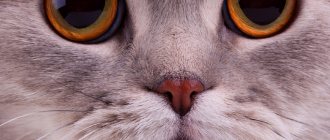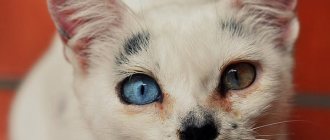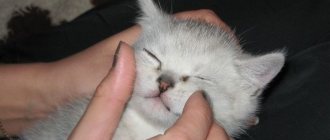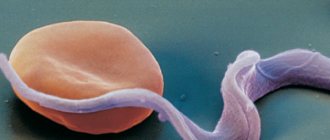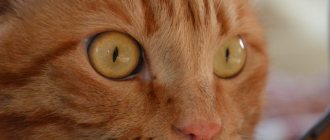Why does the disease develop?
In half of the cases, it is not possible to identify the cause that contributed to the occurrence of uveitis in the cat. However, there are a number of factors that can contribute to the development of pathology:
- External. The disease develops against the background of traumatic damage to the visual organ, burns.
- Internal. The disease can be provoked by infectious, bacterial, fungal and tumor lesions of the body.
If the cause cannot be identified, the disease is called idiopathic uveitis.
Drugs for treatment
Dexamethasone is used to treat uveitis from the first days.
In addition to medications whose action is aimed at treating the root cause of the disorder, drugs from the following groups are used as part of the treatment of uveitis:
- non-steroidal drugs for internal use (Meloxicam and Caprofen) and local use (Suprofen, Diclofenac and Flurbiprofen);
- steroids intended for subconjunctival administration (Dexamethasone and Triamcinalone);
- medications of the corticosteroid group for local use (Prednisolone acetate);
- mydriatics for pain relief (Atropine and Tropicamide);
- carbonic anhydrase inhibitors (Brinzolamide and Dorzolamide);
- immunomodulators (Azathioprine and Cyclosporine);
- antibacterial drugs for topical use (ointments and gels based on tetracycline).
It is important to realize that in order to eliminate painful manifestations and prevent severe consequences, it is necessary to carry out complex treatment, influencing the factors that caused the disease, as well as the symptoms resulting from this disorder.
Types of uveitis
Inflammation can be localized in various areas and structures of the visual organ, therefore the pathology is divided into 5 types based on the affected area of the choroid:
If the inflammatory process has affected the iris, then we should talk about iridocyclitis.
- Iridocyclitis. It is an inflammatory process in the iris and ciliary body.
- Iritis. Inflammation of the iris.
- Cyclic. Pathology of the ciliary body.
- Choroiditis. Inflammatory process in the choroid.
- Panuveitis. Inflammation of all parts of the choroid of the eyeball.
Causes of the disease
The inflammatory process in the area of the vessels supplying blood to the eyeball is called uveitis. The vascular network is located in the middle part of the eye and is the median membrane. The uveal tract, where inflammation occurs, is represented not only by vessels, but also by other structures - the iris, ciliary body and choroid (the choroid itself). In the anterior part of the uveal tract is the iris and ciliary body. In the posterior part there is only the vascular network.
Depending on which part of the uveal tract is affected, several types of uveitis are distinguished in veterinary medicine. The following types of inflammation of the choroid are distinguished:
- The anterior form of uveitis is characterized by an inflammatory process in the area of the iris and ciliary body. Its scientific name is iridoccilitis.
- The posterior form of the pathology is characterized by inflammation in the area of the vascular network, called choroiditis.
- Panuveitis is a disease manifested by inflammation of all structures of the uveal tract.
A dense network of vessels, forming the membrane, is located between the fibrous membrane and the retina. The fibrous membrane is based on the corneal layer and sclera, and the retina is formed by internal structures. As the pathology develops, inflammation may not be localized in one place, but may spread to nearby tissues of the eyeball. In this case, the following pathologies develop:
- Endophthalmitis is an inflammatory pathology affecting the anterior part of the eye, the vitreous body and nearby tissues of the visual organ.
- Panophthalmitis is an inflammation diagnosed in the case of an advanced course of a certain pathology. Panophthalmitis is characterized by the involvement of all tissue structures in the inflammatory process - the choroid, fibrous membrane and retina.
There are several factors that provoke the development of uveitis in cats. The main ones are:
- chronic diseases of the organ of vision - cataracts, high blood pressure in the eye, ulcerative lesions of the corneal layer;
- mechanical eye lesions – bruises;
- systemic pathologies - various infectious factors, pathologies of the endocrine system, lead to inflammation in the visual apparatus.
In domestic cats, systemic pathologies play an important role in the development of uveitis. The risk of developing eye disease increases if the animal has viral leukemia, toxoplasmosis, viral peritonitis or herpes virus. Feline viral immunodeficiency plays a special role in the development of inflammation of the vascular system of the visual apparatus.
Separately, it is worth noting fungal pathologies. Infection of a cat with coccidomiasis, asperigillosis or blastomycosis provokes systemic changes in the body. Differential diagnosis is based on the clinical picture of manifestations and anamnesis. It is noted that with blastomycosis, cryptococcosis, and coccidioidomycosis, the posterior part of the uveal tract is affected. With fungal diseases, eyelid lesions occur. There is a constant discharge of specific exudate from the eyes.
The following types of pathologies can cause damage to the uveal tract and provoke uveitis in pets:
- bacterial damage (hemobartonellosis);
- helminthiasis – damage to the body by dirophyllaria (heartworms) and toxocara (inflammation is provoked by the migration of larvae through the body of some worms);
- damage by protozoan microorganisms (for example, toxoplasmosis).
Among the reasons for the development of inflammation of the vessels of the visual apparatus, metabolic disorders are distinguished. One of the most common is systemic hypertension. Uveitis in a cat can be provoked by tumor processes - primary tumors in the optic organ or systemic neoplasms - metastases, lymphosarcoma, hemangiosarcoma.
Diagnostic measures
With such a pathology, the animal must be fully examined by a doctor.
If a cat owner notices problems with the pet's visual organs, it is important to contact a veterinary clinic as soon as possible. First of all, the doctor will conduct a survey of the owner, during which he will find out how long ago the unwanted symptoms began, whether there was trauma to the organs of vision or other eye diseases. Then the veterinarian begins a general examination of the pet and sends it for a general examination of urine and blood. This is followed by an instrumental examination of the visual organs and analysis of the intraocular fluid.
Since uveitis has similar symptoms to other eye diseases, the cat is often prescribed additional tests to rule out these pathologies. First of all, the disease should be distinguished from glaucoma, the course of which is accompanied by pupil dilation and increased intraocular pressure. It is also necessary to exclude conjunctivitis, as a result of which there is an increased secretion of tears and redness of the mucous membrane of the organ of vision.
Symptoms
The clinical picture largely depends on the location of the inflammation. However, general symptoms of ocular uveitis in cats can be identified:
- redness of the sclera;
- frequent production of tears;
- soreness in the eyes;
- fear of bright light;
- swelling of the eyelids;
- the appearance of blood clots in the organ of vision;
- narrowing and changing the shape of the pupils;
- lack of pupillary response to light stimuli;
- lethargy, apathy, signs of general malaise.
With anterior uveitis, you may notice a pink halo around the iris. The animal's vision deteriorates, and exudate accumulates on the eyeballs. The pupil stops responding to light. The cat constantly squints and shakes its head due to photophobia and pain in the eyes. Often the color of the iris of the affected eye changes in a pet. Light colored patches can be seen on the cornea.
With posterior uveitis, visual impairment is often observed. Diagnosing this form of the disease on your own is quite difficult. Choroiditis and chorioretinitis can only be diagnosed by a veterinary ophthalmologist. Sick cats experience swelling and redness of the fundus, as well as changes in the shape of the iris.
With panuveitis, signs of damage to the iris and retina are combined with symptoms of inflammation of the choroid. This form of pathology has the most unfavorable prognosis.
How is the treatment carried out?
Basic scheme
Some pets only need pills to recover.
Therapy for iritis and uveitis in a pet is directly related to the factor that provoked the occurrence of the pathology. When the cause is a malignant tumor, veterinarians prescribe removal of the affected eye. However, in this situation, it is important to understand that the metastases have not spread to other organs. If the cause of the eye pathology is not a tumor, the pet is often prescribed anti-inflammatory treatment. Sometimes it is enough to use exclusively the tablet form of medications. In this case, the physician must determine how high the likelihood of glaucoma, which often accompanies uveitis, is.
If the veterinary clinic to which the pet owner contacted does not have a tonometer that allows you to measure intraocular pressure, it is important to take the cat to a veterinary ophthalmologist. Neglect of this recommendation and lack of proper treatment can provoke the development of glaucoma, as a result of which the animal will permanently lose its vision. In some situations, even surgical removal of the affected visual organ is required.
Required medications
If the risk of developing a pathology accompanied by increased pressure inside the eyes is high, the animal may be prescribed corticosteroids. However, the owner should be aware that their use is prohibited when there are ulcers on the cornea. In addition, such medications have a number of serious side effects. Veterinarians are convinced that only corticosteroids should be used for external use. The most commonly prescribed drug is Prednisolone acetate. General medications are prescribed only in situations where the likelihood of complete blindness is very high.
Tropicamide is often prescribed to such sick pets.
The treatment regimen for uveitis also involves the prescription of mydriatics, which help relieve spasm of the ciliary muscle, and therefore pain. In addition, medications from this group reduce the risk of pathogens entering the blood. Often it is necessary to treat uveitis in a cat with the help of Tropicamide and Atropine. Carbonic anhydrase inhibitors, for example Dorzolamide, are also prescribed for pets. Therapy is not complete without immunomodulators; Cyclosporine is considered one of the most effective. The exact dosage and duration of therapy for all medications is determined by the veterinarian.
Uveitis in cats and dogs
Uveitis is considered one of the most severe pathologies of the visual organs in animals. This disease negatively affects the choroid of the eye, causing its inflammation (see photo ).
The blood supply to the eyeball is provided precisely by small capillaries and blood vessels. This blood supply system is called the uveal tract - hence the name of the disease itself.
It is this disease that most often deprives our pets of vision.
Causes of uveitis
There are several reasons that can trigger the occurrence and development of uveitis, including:
- pathologies of the visual apparatus (for example, cataracts, glaucoma, corneal ulcers and others);
- bruises or contusion of the organ of vision;
- diseases in the body that are in the nature of systemic inflammation (pathologies, infections, etc.).
Among all the reasons voiced, the most common was the last one. The risk of getting inflammation of the vascular network of the eye in cats increases if the animal suffers from leukemia, toxoplasmosis, viral peritonitis (FIP), herpevirus (FHV-1), or viral immunodeficiency. The diseases that most often provoke this problem in dogs are plague, leptospirosis, brucellosis, babesiosis, and borreliosis.
Symptoms
Clinical signs of uveitis in dogs and cats are: pain in the eye, lacrimation, photophobia, the animal squints and scratches the eye, constriction of the pupil, corneal edema, turbidity of the intraocular fluid, blood in the anterior chamber of the eye, etc. Often, pet owners note decreased vision, even complete blindness.
Uveitis in dogs and cats can develop both acutely (several days) and chronically (over several months).
It is also worth noting that the serious consequences of uveitis can be secondary glaucoma, cataracts, retinal detachment, and atrophy of the eyeball.
Symptoms of the disease
Uveitis in dogs and cats often manifests itself as follows:
- noticeable lacrimation;
- pain;
- fear of bright light;
- the pet constantly tries to comb its eyes and squints;
- the pupil narrows;
- the cornea of the eye swells;
- the intraocular fluid becomes cloudy;
- blood is observed that flows into the anterior chamber of the optic organ.
In addition, an attentive owner will notice that the animal seems to be losing orientation in space, which may symbolize deterioration of vision.
This insidious disease often attacks unexpectedly and develops rapidly, worsening the pet’s well-being literally in a matter of days. Sometimes it occurs less obviously in a chronic form - then changes in the pet’s condition can be observed over the course of several months.
In addition to the fact that uveitis can cause complete loss of vision, it is also dangerous due to all sorts of complications, for example: retinal detachment, cataracts, secondary glaucoma, and atrophy of the eyeball.
How is uveitis diagnosed?
As with other serious ophthalmological diseases, this diagnosis is made after comprehensive examinations of the affected animal. Mandatory studies include ophthalmoscopy, tonometry (determination of intracranial pressure), biomicroscopy (study of structures), gonioscopy (assessment of the situation in the anterior chamber), fundoscopy (examination of the back of the apple). Sometimes, in order to take a closer look at the condition of the retina, vitreous body and other structures, an ophthalmologist prescribes an ultrasound.
Laboratory tests also play an important role in recreating the picture of the animal’s condition: blood tests (general clinical, biochemical), the presence of infections. In addition, the attending physician must have access to the pet's medical history.
Treatment of uveitis in cats and dogs
As we have already said, uveitis is not the root cause, but a consequence of a certain disease. And to solve this problem, it is necessary to correctly diagnose the cause of its occurrence.
Most often, during treatment, a specialist prescribes eye drops that will help relieve inflammation of the network of blood vessels, pain, prevent complications and generally relieve pain and discomfort. In addition, depending on the situation, systemic therapy is prescribed to improve the condition of the entire body.
Since uveitis causes severe discomfort in your pet, it is important to carefully observe the appearance of its visual organs in order to detect the development of ophthalmological problems in time!
Possible complications
When timely treatment for uveitis in cats is not carried out, the possibility of serious consequences cannot be excluded. Veterinarians note that there are frequent cases of disruption of the shape of the pupil, as well as dislocation of the lens of the visual organ. Uveitis can also provoke the occurrence of cataracts, which is a clouding of the transparent body that provokes varying degrees of visual impairment. The most dangerous consequences that the disease can cause are retinal detachment, as well as the occurrence of a secondary form of glaucoma. The pathology cannot be treated and leads to blindness of the animal, so it is important for owners to remember that if any complications develop, they should not delay a visit to the veterinary clinic. This will allow possible eye pathologies to be identified as quickly as possible and treated in a timely manner, avoiding undesirable consequences.
What are the causes of uveitis?
Veterinarians say that in approximately 60% of cases the true cause of the disease cannot be reliably identified. But usually everything is quite banal: injuries, the same conjunctivitis or cancer in old cats. The most common infectious diseases that can cause uveitis (most likely in kittens): bartonellosis, feline infectious peritonitis (FIP), toxoplasmosis, feline immunodeficiency virus (FIV), feline herpes virus 1 (FHV-1) and feline leukemia virus (FeLV ). As for oncological problems, lymphoma and melanoma rule the roost. Sometimes one can only guess about the reason for their occurrence.
Discussion of these diseases is beyond the scope of this article. It is only important to know that all of them can be life-threatening for your pet, with the possible exception of the feline herpes virus. However, the latter is fraught with a sharp decrease in the animal’s immune status, which can lead to the development of secondary infections.
What's the prognosis?
The outcome of the disease in cats is directly related to various factors. First of all, doctors take into account the disease that caused uveitis and the severity of its course. The prognosis is also influenced by the individual characteristics of the pet, as well as the presence of concomitant pathologies. It is important to carry out timely diagnostic measures and the correct treatment regimen. An important factor when making a prognosis is the age of the pet. The earlier the pathology is detected, the more favorable the prognosis is made by veterinarians. When the cause of the disease cannot be determined, the animal may be prescribed lifelong treatment. In advanced situations or serious complications, surgical removal of the optic organ is sometimes required.
Therapeutic measures
Surgical treatment is indicated only for tumor processes.
Features of the treatment of uveitis depend on the reasons that caused this disease. In cases where the disorder is oncological in nature, surgical treatment is used and the damaged eye is removed. But such a measure is justified only in situations where metastases have not spread to other parts of the body.
In other cases, treatment is carried out with medications. Therapy includes:
- Address the root cause, if found, and treat the underlying disease.
- Elimination of the inflammatory process to prevent the development of other visual disorders.
- Relieving pain, since uveitis is often accompanied by severe headaches.
- Control of intraocular pressure to prevent glaucoma.
- Maintenance therapy to improve the general condition of the cat.
When deciding how to treat uveitis, experts are guided by factors such as the causes that provoked the disease, the age and individual characteristics of the cat’s body.
Forecast
The prognosis for uveitis is favorable with timely treatment. In this case, it is possible to relieve inflammation and maintain normal vision. It is imperative to treat the underlying disease, otherwise relapses of uveitis are possible.
Often inflammation of the vascular tract becomes chronic. In this case, the cat needs lifelong medication.
If the cause of uveitis is a malignant ocular tumor, the prognosis of the disease is complicated. It is not always possible to preserve the organ of vision. Most often, you have to undergo surgery to remove the eye.
Drug treatment
In most cases, uveitis can be treated conservatively. If it is possible to determine the cause of inflammation of the vascular tract of the eye, then it is necessary to treat the underlying pathology.
To prevent the spread of inflammation to other tissues, corticosteroid hormones are prescribed:
- "Triamcinolone";
- "Diprospan";
- "Methylprednisolone."
These drugs are administered as injections under the mucous membrane of the eye. Injections should not be given if there are ulcers on the cornea.
Anti-inflammatory eye drops and ointments are used for local treatment:
- "Diclofenac";
- "Ibuprofen";
- "Ketarolac";
- "Suprofen."
The use of drops to dilate the pupil (mydriatics) based on atropine and adrenaline is also indicated. They are prescribed in short courses. You should not get carried away with such drugs, as they have many side effects.
In case of uveitis, antibiotic therapy is mandatory. Antibacterial agents are given to the animal in the form of tablets or administered intramuscularly.
It is important to remember that under no circumstances should you treat an animal for uveitis on your own. This is a rather complex disease that cannot be cured with home remedies.
Diagnostics
An experienced veterinarian may suspect uveitis in an animal during an examination. This disease is accompanied by characteristic symptoms: inclusions on the cornea, severe redness of the sclera, swelling of the eyelids. To clarify the diagnosis, the following examinations are prescribed:
- fundus examination;
- Ultrasound of the eye;
- measurement of intraocular pressure;
- examination of eye discharge for bacterial culture and cytology.
It is very important to determine the cause of uveitis. For this purpose, a serological blood test is prescribed for antibodies to microorganisms.

